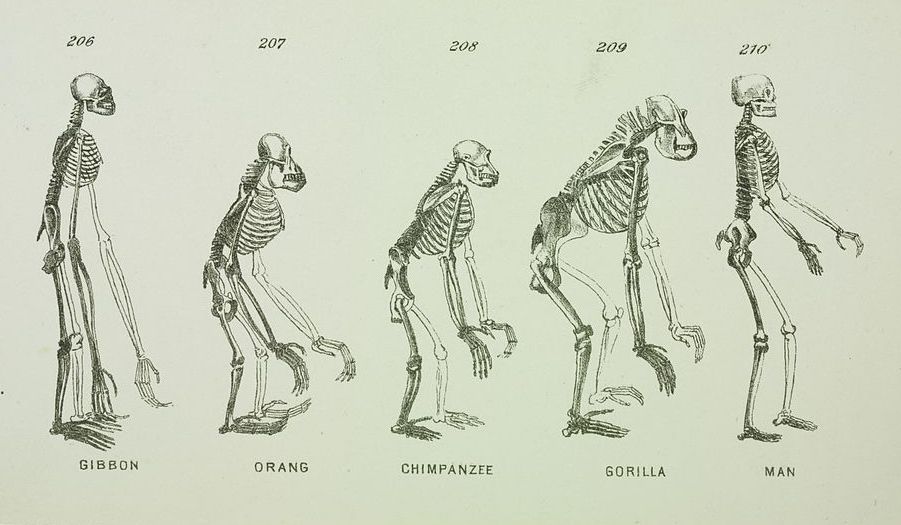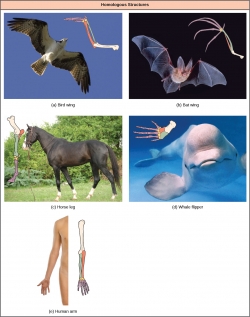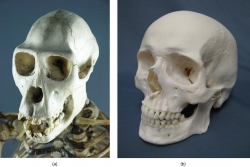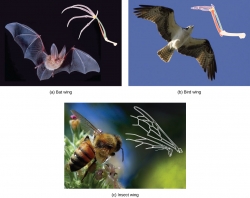
Over 500 Science and History Articles Absolutely Free
We made all 5th grade reading level versions of our curriculum free and they're ready to be used in your classrooms.
Evidence for Evolution: Analogous and Homologous Structures
fossil record, homologous structure, analogous structure, vestigial structure, evolution
Evolution Unit
The evidence for evolution is compelling and extensive. Looking at every level of organization in living systems, biologists see the signature of past and present evolution. Darwin committed a large part of his book, On the Origin of Species, to identify patterns in nature that were consistent with evolution, and since Darwin, our understanding has become clearer and broader. Evolution is when organisms adapt over time to their environments in ways that help them live long enough to reproduce. This causes entire groups of living things to change because the parents pass on what helped them live to their children.
Fossils
Fossils provide solid evidence that organisms from the past are not the same as those found today; fossils show a progression of evolution. Scientists figure out the age of fossils and categorize them all over the world to determine when the organisms lived relative to each other. The fossil record that comes from this includes all the fossils scientists have found to tell a story of the past and show the evolution of form over millions of years.
For example, highly detailed fossil records have been recovered for sequences of species in the evolution of whales and modern horses. The fossil record of horses in North America is quite rich, and many contain transition fossils: those showing intermediate anatomy between earlier and later forms. The fossil record goes back to a dog-like ancestor some 55 million years ago that gave rise to the first horse-like species 55 to 42 million years ago in the genus Eohippus. The series of fossils tracks the change in anatomy that resulted from a gradual drying trend that changed the landscape from a forested one to a prairie. Successive fossils show the evolution of teeth shapes and foot and leg anatomy to a grazing habit with adaptations for escaping predators. One example of this is in the species of Mesohippus found from 40 to 30 million years ago. Later species showed gains in size, such as those of Hipparion, which was around from about 23 to 2 million years ago. The fossil record shows several adaptive radiations in the horse lineage, which is now much reduced to only one genus, Equus, with several species.

A set of paintings on a timeline from 55 million years ago to today showing 4 of the ancestors to the horses of the present.
The first in the series is Eohippus, which lived from 55 to 45 million years ago. It was a small, dog-sized animal with 4 toes on the front feet and 3 on the back, a long tail, and a brown spotted coat. The second is Mesohippus, which lived from 40 to 30 million years ago. It was slightly larger than Eohippus with longer legs. It had 3 toes on the front and back feet. The third is Hipparion, which lived from 23 to 2 million years ago. It walked on its middle toe on each foot (now a hoof), but it still had vestiges of the remaining toes. It was much larger than Mesohippus. The fourth is Przewalski's horse, a recent but endangered horse. It is smaller and stockier than the domesticated horse with one toe (hoof) on each foot.
This drawing shows an artist's renderings of these species derived from fossils of the evolutionary history of the horse and its ancestors. The species depicted are only four from a very diverse lineage that contains many branches, dead ends, and adaptive radiations. One of the trends shown here is the evolutionary tracking of a drying climate and increase in prairie versus forest habitat reflected in forms that are more adapted to grazing and predator escape through running. Przewalski's horse is one of a few living species of horse.
Anatomy
Another kind of evidence for evolution is the presence of structures in organisms that share the same basic form. For example, the bones in the appendages of a human, dog, bird, and whale all share the same overall construction. That similarity results from their origin in the appendages of a common ancestor. Over time, evolution led to changes in the shapes and sizes of these bones in different species, but they have kept the same overall layout, evidence of descent from a common ancestor. Scientists call these similar parts homologous structures. Some structures exist in organisms that have no clear function at all and appear to be residual parts from a past ancestor, such as the fact that some snakes have pelvic bones despite having no legs because they descended from reptiles that did have legs. Vestigial structures are parts left over in organisms that do not have a clear role in the body. They come from a past ancestor that did use the body part at one time, but have not been lost because they do not hurt the organisms ability to live. Other examples of these kinds of structures are wings on flightless birds (which may have other functions), leaves on some cacti, traces of pelvic bones in whales, and the sightless eyes of cave animals.

This drawing compares a human arm, dog and bird legs and a whale flipper. All of these limbs have the same bones, but the size and shape of these bones can be different.
The similar construction of these appendages shows that these organisms share a common ancestor.
Similarity of Form
Another piece of evidence to support evolution is the convergence of form in life forms that share similar environments. For example, species of unrelated animals, such as the arctic fox and ptarmigan (a bird), living in the Arctic region have temporary white coverings during winter to blend with the snow and ice. The similarity happens not because of common ancestry, indeed one covering is of fur and the other of feathers, but because of similar selection pressures, the benefits of not being seen by predators.

Both the arctic fox and ptarmigan have evolved a color that helps them blend into their surroundings. They aren't related, but have evolved in a similar environment.
Two Measures of Similarity
Organisms that share similar physical features and genetic sequences tend to be more closely related than those that do not. Features that overlap both in their form and genetically are referred to as homologous structures; the similarities stem from common evolutionary paths. For example, as shown in The next image, the bones in the wings of bats and birds, the arms of humans, and the foreleg of a horse are homologous structures. Notice the structure is not simply a single bone, but rather a grouping of several bones arranged in a similar way in each organism even though the elements of the structure may have changed shape and size.

Photo A shows a bird in flight with a drawing of bird wing bones. B shows a bat in flight with a drawing of bat wing bones. C shows a horse with a drawing of front leg bones. D shows a beluga whale with a drawing of flipper bones. E shows a human arm with a drawing of arm bones.
All the limbs share common bones, analogous to the bones in the arms and fingers of humans. However, in the bat wing, finger bones are long and separate and form a scaffolding on which the wing's membrane is stretched. In the bird wing, the finger bones are fused together. In the horse leg, the ulna is shortened and is fused to the radius. The hand bones are reduced to one long thick bone, and the finger bones are reduced to one long thick finger with a modified nail or hoof. In the whale flipper, the humerus, ulna, and radius are very short and thick.
Bat and bird wings, the foreleg of a horse, the flipper of a whale, and the arm of a human are homologous structures, showing that bats, birds, horses, whales, and humans share a common evolutionary past.
Misleading Appearances
Some organisms may be very closely related, even though a minor genetic change caused a major morphological difference to make them look quite different. For example, chimpanzees and humans, the skulls of which are shown in the next image are very similar genetically, sharing 99 percent of their genes. However, chimpanzees and humans show major anatomical differences, including the degree to which the jaw protrudes in the adult and the relative lengths of our arms and legs.

A chimpanzee skull and a human skull. Though we look different from the outside, we share 99% of the same genes.
However, unrelated organisms may be distantly related yet appear very much alike, usually because of common adaptations to similar environmental conditions evolved in both. An example is the streamlined body shapes, the shapes of fins and appendages, and the shape of the tails in fishes and whales, which are mammals. These structures bear superficial similarity because they are adaptations to moving and maneuvering in the same environment, water. When a characteristic that is similar occurs by adaptive convergence (convergent evolution), and not because of a close evolutionary relationship, it is called an analogous structure. In another example, insects use wings to fly like bats and birds. We call them both wings because they perform the same function and have a superficially similar form, but the embryonic origin of the two wings is completely different. The difference in the development, or embryogenesis, of the wings in each case is a signal that insects and bats or birds do not share a common ancestor that had a wing. The wing structures, shown in the next image evolved independently in the two lineages.

The wings of a bat, bird and bee all look fairly similar, but evolved in different ways to solve the same problem: flight.
Traits can be either homologous or analogous. Homologous traits share an evolutionary path that led to the development of that trait, and analogous traits do not. Scientists must determine which type of similarity a feature exhibits to figure out the phylogeny of the organisms being studied.